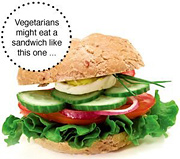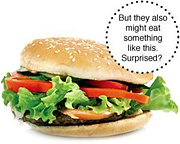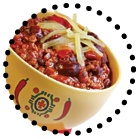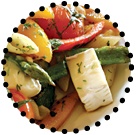Going Veggie?
By Meghan Vivo
It's a common misconception that adopting a vegetarian diet means eating a limited number of basic, bland foods. Wrong. In fact, these days, even conventional supermarkets and restaurants offer a variety of tasty meatless options. Here's a brief introduction to the health benefits - and potential pitfalls - of going veggie. To eat meat or not to eat meat - the decision is unquestionably a personal one. For decades, choosing not to eat meat and other animal products was considered "alternative." Although vegetarianism is still a minority approach, it has grown steadily in popularity over the years. The American Dietetic Association has officially endorsed vegetarianism, concluding that "appropriately planned vegetarian diets are healthful, are nutritionally adequate, and provide health benefits in the prevention and treatment of certain diseases." Vegetarianism Defined
 The main premise of a vegetarian diet is eating plant-based foods, such as fruits, vegetables, whole grains, lentils, nuts and seeds. The three major groups of vegetarians include: 1) vegans, the strictest type, who eat only plant-based foods and completely remove all foods from animals and animal products from their diets (including honey and gelatin); 2) lacto-vegetarians, who eat dairy products but exclude eggs, meat, fish and poultry; and 3) lacto-ovo vegetarians, who eat dairy products and eggs but omit all meat products.
The main premise of a vegetarian diet is eating plant-based foods, such as fruits, vegetables, whole grains, lentils, nuts and seeds. The three major groups of vegetarians include: 1) vegans, the strictest type, who eat only plant-based foods and completely remove all foods from animals and animal products from their diets (including honey and gelatin); 2) lacto-vegetarians, who eat dairy products but exclude eggs, meat, fish and poultry; and 3) lacto-ovo vegetarians, who eat dairy products and eggs but omit all meat products.
 In addition to consuming all types of plant-based foods, vegetarians have a number of meatless options, such as tofu dogs, soy burgers or texturized vegetable protein, which simulate the taste and texture of meat and often have fewer calories and less fat. If you don't like a particular product the first time you try it, try a different brand or method of preparation the second time. For example, most people have definite brand preferences in veggie burgers, and the taste can vary drastically depending whether you microwave, bake or grill them.
In addition to consuming all types of plant-based foods, vegetarians have a number of meatless options, such as tofu dogs, soy burgers or texturized vegetable protein, which simulate the taste and texture of meat and often have fewer calories and less fat. If you don't like a particular product the first time you try it, try a different brand or method of preparation the second time. For example, most people have definite brand preferences in veggie burgers, and the taste can vary drastically depending whether you microwave, bake or grill them. Health Benefits Since cholesterol is found in animal products such as meat, dairy and eggs, going veggie can be an ideal way to consume less fat and cholesterol and more fiber, without sacrificing taste and variety. Many studies have shown that replacing animal protein with plant protein lowers blood cholesterol levels. Additionally, a large number of studies, dating back to the early 1920s, indicate that a vegetarian diet may lower blood pressure. A vegetarian diet high in complex carbohydrates and fiber and low in fat also can help control diabetes and may help prevent cancer. Studies show that vegetarians' death rates from cancer are only one-half to three-quarters of the general population's rates. Breast and colon cancer rates also are lower in vegetarians, as is the likelihood of developing kidney stones or gallstones. While the reasons for these health benefits aren't entirely understood, the evidence supports the benefits of a well-planned vegetarian diet. Common Pitfalls Although the potential health benefits are clear, a wholesome vegetarian diet is more complex than simply deleting meat from your favorite meals, filling up on fast food or eating a salad a day. Many vegetarians report feeling tired, weak and generally unhealthy, usually because they aren't supplementing their diets with the nutrients meat would ordinarily provide. Here are a few key nutrients you'll need to focus on to make sure you're getting proper nutrition: Protein Protein is essential to maintain healthy skin, bones, muscles and organs. According to some experts, many nonvegetarians actually consume too much protein, which can lead to osteoporosis, kidney disease, calcium stones in the urinary tract and some cancers. In general, women need around 45 grams per day and men need 55 grams. One cup of tofu contains roughly 20 grams of protein which, combined with eggs, dairy or other high-protein foods, can be sufficient for a healthy diet. Excellent sources of protein include soy products, meat substitutes, legumes, lentils, nuts, peanut butter, vegetables, tofu, eggs, dairy products, seeds and whole grains. Calcium Calcium can be found in low-fat dairy products like milk and yogurt, and dark green vegetables like spinach, collard greens, kale and broccoli. It is essential for building strong teeth and bones. You also can find tofu, soymilk and juices enriched with calcium. Given women's heightened risk for osteoporosis, a calcium supplement may be necessary. Vitamin D Vitamin D helps calcium reach our bones. The best sources are cow's milk and sunshine, followed by fortified soymilk and fortified breakfast cereals. In some cases, supplementation may be necessary, particularly during the winter months. Vitamin B12 Vitamin B12 helps your body produce red blood cells to prevent anemia, and is naturally found only in animal products. Good sources include milk, eggs, cheese, enriched cereals, fortified soy products or supplements. Iron Iron also is important for the creation of red blood cells. You can increase iron consumption with dried beans and peas, lentils, enriched cereals, whole-grain foods, dark, leafy green vegetables, and dried fruit. To properly absorb iron, your body simultaneously needs foods high in vitamin C, like citrus fruits, tomatoes, cabbage and broccoli. Again, women are especially prone to iron deficiency and should consult their doctor about the potential need for supplementation. Zinc Zinc plays a critical role in cell division and the formation of proteins. It can be found in whole grains, soy products, nuts and wheat germ. How To Get Started Variety is the key to any healthy diet. No single type of food can provide all of the nutrients you need, so mix in as many healthy ingredients as possible. Here are three steps to get you started on a well-balanced, easy-to-maintain vegetarian diet: - Start with what you know. Spaghetti, vegetable stir-fry, vegetable lasagna and veggie pizza are some examples of meatless meals you may already be eating.
- Choose a few meals you're already serving that can easily become meatless with a couple substitutions, such as replacing black beans or soy crumbles for beef in vegetarian chili. Chicken in fajitas, stir-fry and tacos can easily be replaced with tofu.
- You can find hundreds of additional vegetarian meal ideas on the Internet or in vegetarian cookbooks. The trick is being willing to try new things and explore local health food stores for interesting meal ideas.
If you're going out for dinner, Indian, Middle Eastern, Greek, Thai and Chinese restaurants are known for offering a large selection of meat-free cuisine, and restaurants catering solely to vegetarians are popping up with greater frequency. Most importantly, be sure to limit your intake of sweets, fatty foods and unhealthy carbohydrates. This is a common trap for vegetarians and inevitably will lead to low energy and poor overall health. A vegetarian diet, if done properly, can be a healthy life choice for anyone at any age, from children and teenagers to elderly and pregnant women. Before you get started, talk to your doctor to make sure you are getting adequate nutrition and making positive, informed decisions about your health. Vegetarian or not, consider expanding your food horizons with these simple but delicious vegetarian recipes.
 Vegetarian Chili
Vegetarian Chili - 1 (12 ounce) package frozen burger-style soy crumbles
- 2 (15 ounce) cans black beans, rinsed and drained
- 2 (15 ounce) cans dark red kidney beans
- 1 (15 ounce) can light red kidney beans
- 1 (29 ounce) can diced tomatoes
- 1 (12 fluid ounce) can tomato juice
- 5 onions, chopped
- 3 tablespoons chili powder
- 1 1/2 tablespoons ground cumin
- 1 tablespoon garlic powder
- 2 bay leaves
- salt and pepper to taste
In a large pot, combine meat substitute, black beans, kidney beans, diced tomatoes, tomato juice, onions, chili powder, cumin, garlic powder, bay leaves, salt and pepper. Bring to a simmer and cover. Let the chili simmer for at least 1 hour before serving.
 Vegetarian Penne Pasta
Vegetarian Penne Pasta - 1 pound penne pasta
- 1/2 medium zucchini, chopped
- 1 yellow pepper, sliced into strips
- 1 red pepper, sliced into strips
- 12 ounces asparagus, trimmed and cut into 1-inch pieces
- 1/2 cup chopped parsley
- 4 cloves garlic, minced
- 2 tablespoons olive oil
- 1/4 lb. extra-firm tofu, in strips or cubes
- 1 lemon
- Fresh basil and/or oregano to taste
Cook the pasta for about 8-10 minutes, until tender. Drain and rinse, then set aside. In a large skillet, sauté the tofu, zucchini, asparagus, peppers and garlic in oil on medium heat for about five minutes. In a serving bowl, mix chopped parsley and chopped basil with the cooked pasta. Cut lemon in half and squeeze juice over pasta and mix. Stir in tofu, tomatoes, vegetable mixture and garlic before serving. Add salt, pepper or red pepper flakes to taste.
 Portobello Panini
Portobello Panini - 4 tsp extra-virgin olive oil
- 1 1/2 tsp reduced-sodium soy sauce
- 1 clove garlic, crushed through a press
- 1/2 tsp freshly ground black pepper
- 4 portobello mushroom caps
- 2 large plum tomatoes, seeded, diced
- 1 tbsp sherry vinegar
- 2 ounces soy cheese
- 4 (1/2-inch thick) slices focaccia bread
- 1 cup baby arugula leaves
Marinate mushrooms in 2 tsp of the oil, soy sauce, garlic and pepper. In a small bowl, combine tomatoes, vinegar, cheese, and remaining 2 tsp of the oil. Lightly toast bread slices 2 minutes per side. Grill mushrooms, gill sides down, 4 minutes. Turn caps over and fill with tomato mixture. Cover grill; continue to grill 3 to 5 minutes, until mushrooms are tender but still hold their shape. Place a mushroom over each bread slice. Top with arugula leaves.
Page printed from:
http://www.toyourhealth.com/mpacms/tyh/article.php?id=953&no_paginate=true&no_b=true
|

